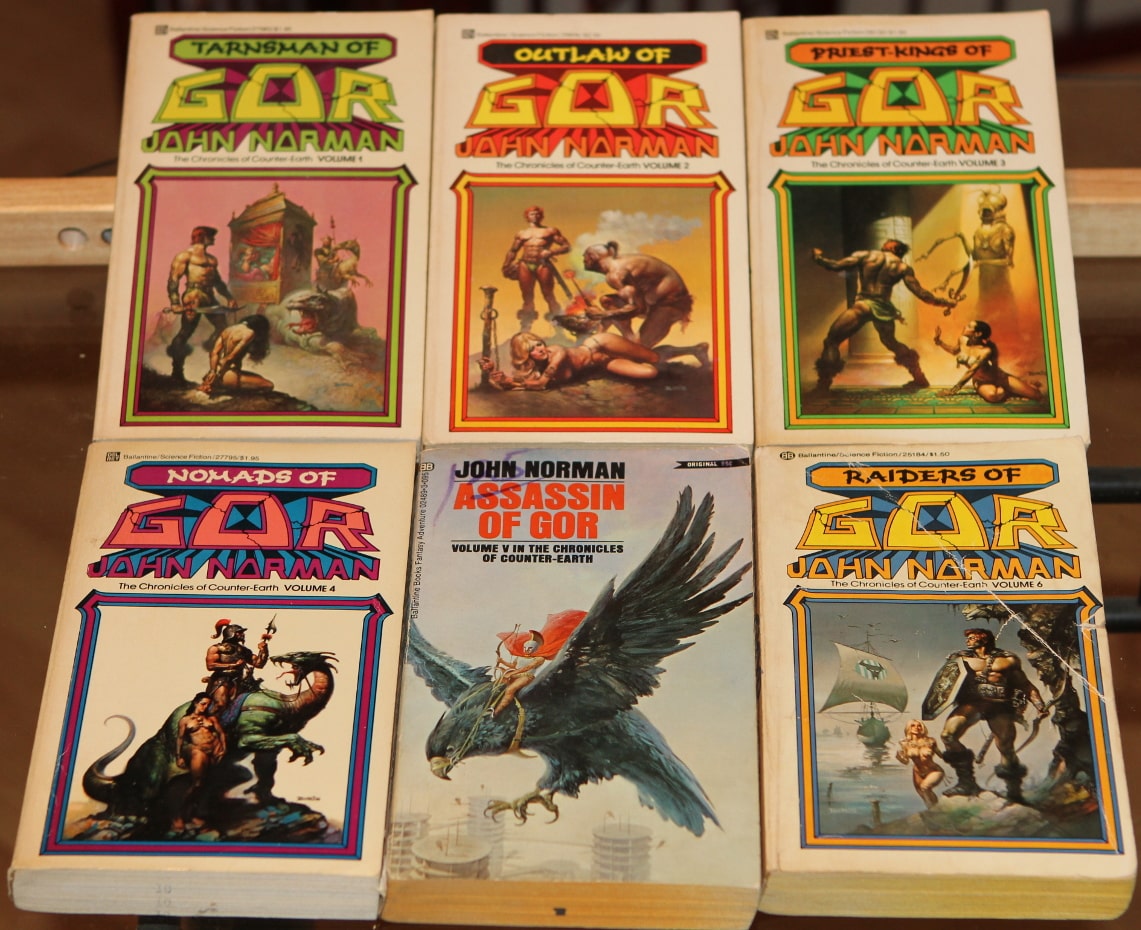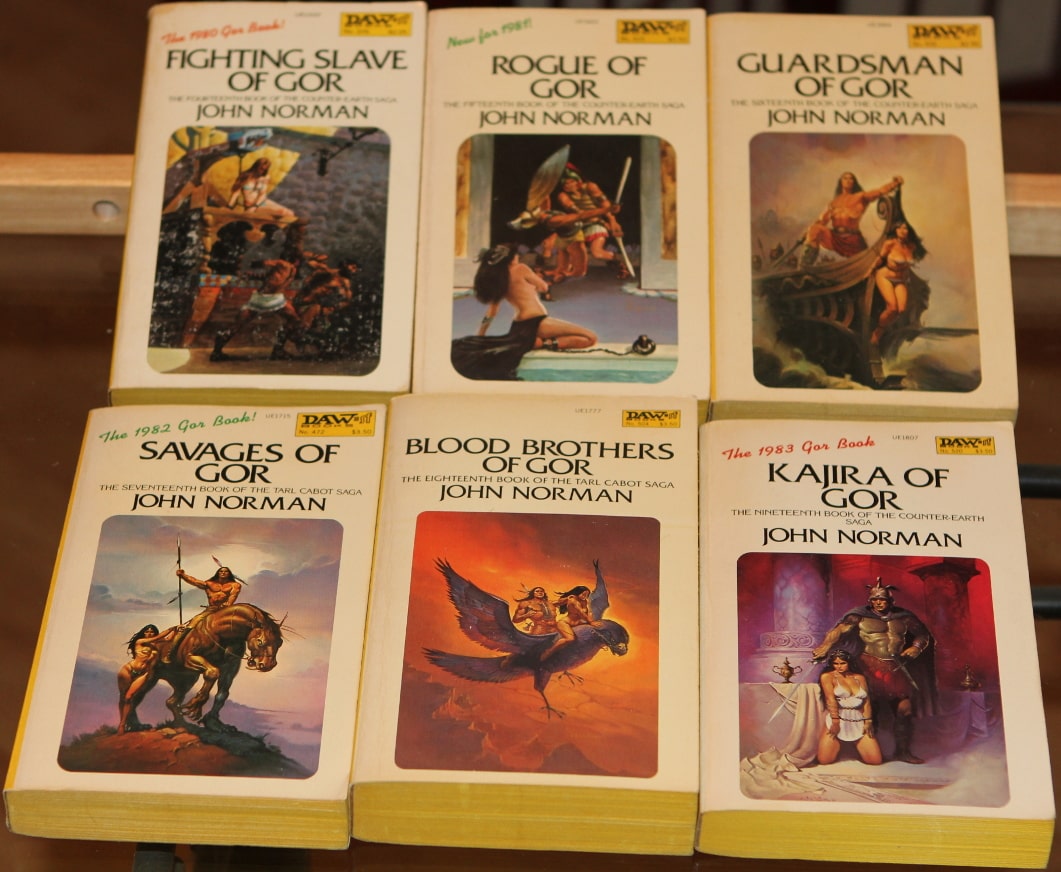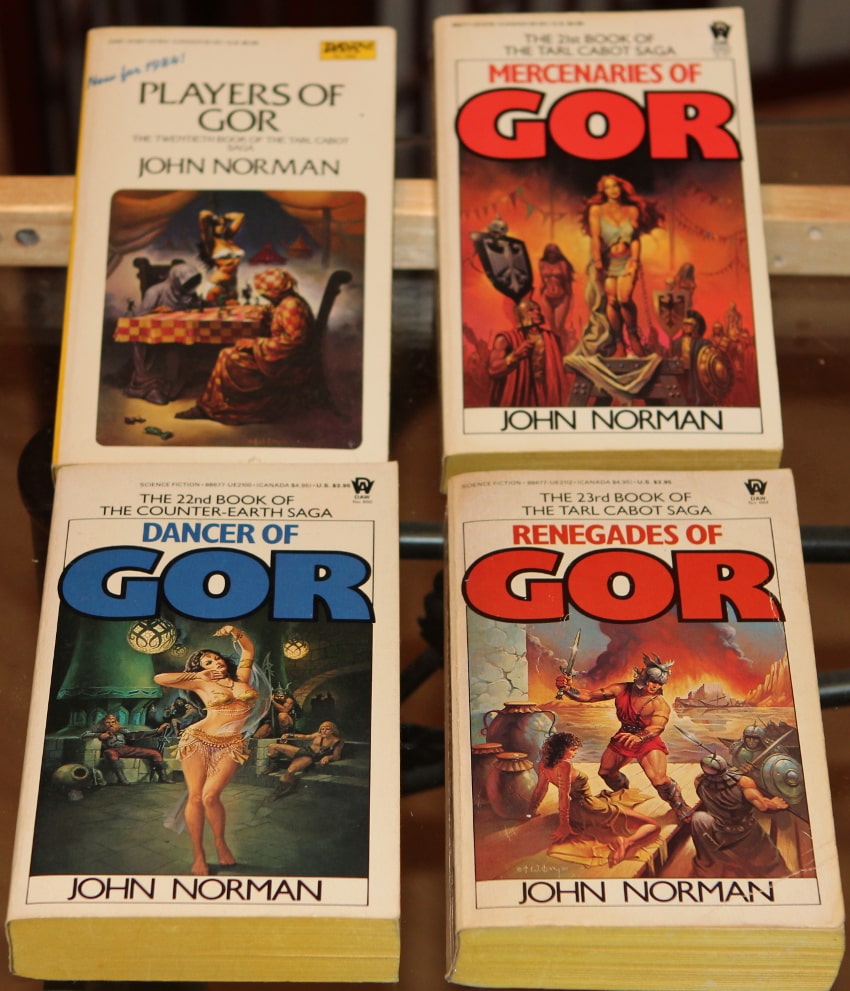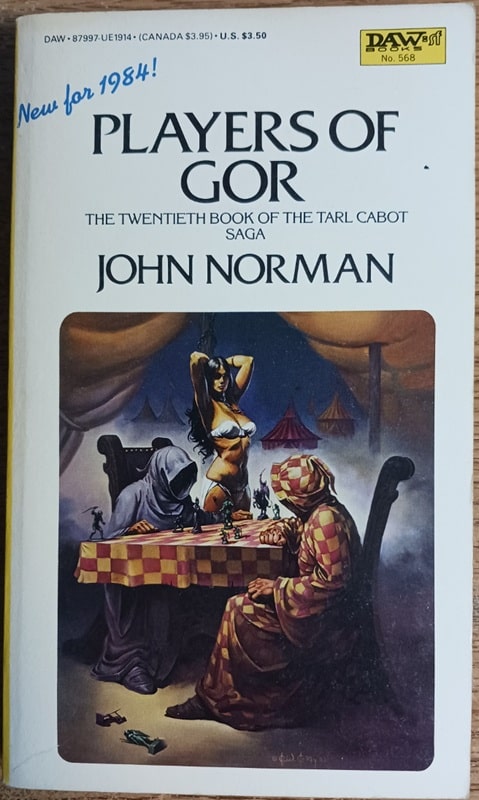The Fundamentals of Sword & Planet, Part II: John Norman

Read Part I of this series, Don Wollheim, Edwin L. Arnold, and Otis Adelbert Kline.
The most controversial of the second generation of Sword & Planet authors was certainly John Norman, which is the pseudonym for author John Lange, a philosophy professor. The first book, Tarnsman of Gor, was published in 1966 and then generally one a year until a break after 1988. There are a total of 37 books at last count but I’ve only personally read up to #23 and don’t own the rest.
From this series, I first read book 2, Outlaw of Gor, which has the main character, Tarl Cabot, enslaved. He must lead a revolt to free himself and other prisoners. Strangely enough, given the later reputation of this series, I found this book in my small town library in Arkansas, in the Bible Belt. That should tell you that the early books in this series were pretty standard fantasy. I found the book quite well written and enjoyable, and began to seek out more. (It was quite a few years until I was able to mail order a copy of Book 1.)
John Lange is a very well educated man and knows a lot about history. He borrowed the concept of the “counter-earth” from Greek philosophers. His planet, Gor, is in orbit directly on the other side of the sun from Earth and thus can never be detected by us (at least in those days.) Lange — as Norman — then liberally sprinkles real history into his fictionalized world. We see civilizations clearly based upon Rome, upon the Mongols, upon the Innuit, and upon Native Americans, as well as on many European sites with the ancient world. And where I am familiar with those histories, I can tell you that Lange is accurate in his portrayals. I once answered a question in a social studies class correctly based upon what Lange had said in one of his books.
Above is a picture of the first six books, and I’ll tell you that I enjoyed all of these, particularly #4: Nomads of Gor, which has Tarl Cabot meeting alternate Mongols. The first few books did not vary much from the John Carter formula, although the world building is deeper. But after #2, each book seemed to introduce a little more erotic elements. In book #6: Raiders, Tarl Cabot is himself enslaved and used sexually (although not in explicit details). This, to me, marked a big swing in the Gor series and the sexual aspects began to move more and more central to the stories, which — to my mind — greatly diminished my enjoyment. This marked the point where Tarl Cabot became “Gorean” and no longer expressed an Earthman’s sentiments and understanding of the world.

After enjoying the first six books, I naturally picked up #7, Captive of Gor. What a huge disappointment. I wondered if it was penned by the same author, but the prose style was the same.
The first six books featured Tarl Cabot, an Earthman, as the main character, but this one featured an Earth woman named Elinor Brinton, a spoiled rich girl who is transported to Gor and made a slave. Cabot only appears briefly as one of her owners. The Elinor character is so completely unbelievable. There’s no depth to her and much of the book has her going back and forth between “I’ll never be a slave” to “I am a natural slave.” This was the first book that really laid out the “Gorean” philosophy that women are natural slaves and will come to love their chains. It was laughable.
Had I not liked the first six books as much as I did, I would have stopped after #7, but I decided to give #8 a go: Hunters of Gor. I hoped for a return to form and it did at least feature Tarl Cabot and have some level of adventure, although there’s very little in the way of plot and way too much of the female sexual slavery thing. It was only marginally better than Captive. I decided I was done, but in the next year appeared Marauders of Gor.
The cover depicted a Viking-esque warrior facing off against a Wendigo looking creature with an axe. I bought it. I read it. And I liked it. Yes, there was a fair amount of the nonsense slave girl stuff, but it had a plot. Tarl must travel to the north to confront the alien enemies of the Priest-Kings, the giant, savage, furred Kurii. There’s a tremendous large scale battle that I liked very much, and I liked the idea that this tied in with the legend of Grendel, that maybe the Grendel from Beowulf was actually a Kur. Skipping over the slavery stuff left a pretty decent story at the heart of this book.
Alas, Marauders was to be the final true spark of quality. Tribesmen of Gor, #10, had a few flickers of story. And then it was over. Slavegirl, Beasts, and Explorers just sagged away to slavery upon slavery. And they were boring. I decided I was done, but then something new happened…

What kept me trying new Gor books? Well, Norman introduced a new character, Jason Marshall, an Earthman who also gets taken to Gor. ERB had done something similar with Ulysses Paxton in Mastermind of Mars, and I rather enjoyed it.
Norman wrote a trilogy about Marshall. The first was Fighting Slave of Gor, then Rogue of Gor and Guardsman of Gor. I hoped the new character meant an action-oriented tale. The first wasn’t bad. It was interesting to see Gor from a new character’s perspective, but the trilogy quickly turned into the same old women-slavery stuff.
I should have quit there. Inertia kept me going, maybe. The next two books offered Tarl Cabot again. He met with alternate Native Americans. A promising idea, but more more more of the same nonsense. Kajira of Gor was next. The very term means slave. I just scanned this one and found it a waste of time.

It turned out, though, that I did pick up a few more Gor books. Gor #20 was called Players of Gor. Norman had talked of these characters before. He invented a version of chess for Gor called Kaissa, played on a 100 square board of red and yellow, and he described it more fully in this book. (The name is based upon Caissa, an invented Goddess of Chess during the renaissance.)
Since at the time I was very much into chess, I bought and read the book. I also remembered fondly ERB’s Chessmen of Mars, in which he introduced Jetan, a Martian version of chess played on a 100 square board of black and orange. ERB included the rules for the game in an appendix in the book, and I even made a Jetan board for myself, though I had to leave it behind when I went to grad school.

Chessmen of Mars was one of my favorite Barsoom books outside of the first three, so I had hopes for Players of Gor. I enjoyed parts of it but the redundant sexual stuff really bogged it down.
I didn’t even try Dancer of Gor. I knew what it would be about, but I tried the next one in the series with the title Mercenaries of Gor. I found it godawful, but I had bought it with Renegades of Gor so I started that one, made it a dozen pages in, and finally, for sure, I was done.
There have been at least ten more Gor books published. I don’t have them. Someone seems to be reading them, but I can’t imagine I’ll ever go back to the series. This series remains for me — personally — my biggest disappointment in a life reading S&P fiction. It started with such promise but it — again in my opinion — went out with whimper instead of a bang.
Charles Gramlich administers The Swords & Planet League group on Facebook, where this post first appeared. His last article for Black Gate was The Fundamentals of Sword & Planet, Part I.
I read the first four back in the 70’s and enjoyed them well enough, but by the end of Nomads (#4) I saw where the road was going and didn’t care to follow it any farther.
there was definitely more and more of the negative slavery stuff that crept in, although I still found a few here and there worth reading.
I think I’ll skip this series.
when the series came out, it was a pretty standard sword & planet series and no one knew where it was headed. People who become aware of it today almost always hear the negative stuff that started later in the series and often then reject the whole idea of the series. That’s fine. No one is required to read it,. It was a very different kind of thing for those of us who discovered it as it was being written.
I imagine it was quite a shock. Picking up a book expecting a fun adventure story and then wondering what on earth happened.
It was. I think I mentioned thinking that 7th book made me think someone else had taken over the series. It was weird
Nice covers, at least. I remember these being all over bookstores and library spinners back in the 80s. I picked up Tarnsman a couple of times (before I knew anything about the trajectory of the series), but never made any headway in it, which, knowing what I know now, I don’t particularly regret.
I read book 2 first and it was quite a bit better than Tarnsman, which I read later
Heh, I’m glad you mentioned the covers. I’m aware of the Gor books by reputation, though I’ve never been curious enough to pick one up, even for a hate read. I was struck as I was reading this article that, for whatever faults the series has, the artwork wasn’t one of them. I’ve always loved the aesthetics of genre illustration from this era, whether science-fiction or fantasy, but I’ve never really paid attention to the artists beyond the biggest names (i.e. Frazetta, Howe, etc.). Now, thanks to Charles’ diligence, I’ve got the beginnings of a rolodex for portfolios to consult when I need inspiration!
oh yes, there are some very cool covers here. Ken Kelly really did some amazing work on this series, and Boris as well.
I have the older Ballantine editions with the more austere Gino D’Achille covers, which I like very much, maybe because I associate his work with Burroughs’ Mars books.
D’Achille was the cover of my first copy of Princess of Mars and the next few books — they transitioned to Whelan around the time I was picking up Chessmen. I love the Whelan covers, but D’Achille’s green Martian on the cover of Princess will always be how I imagine them.
a talented artist for sure.
yes, those were some nice covers he did for the Mars stuff
I admire your stick-to-it-tiveness. 7 lost me and I never went back. 4 was also my favourite.
I suppose I was more of a bulldog back in those days. And there was overall less fantasy to read. Now I’d dop any series that pulled that like it was broiling.
I have SUCH nostalgia seeing this – but a different reason than most would think; Remember the book pit at K-Mart? Where they had this squared off area with scifi/fantasy, news papers, comic books, kid’s books, magazines… It was a mini bookstore within, usually next to the Deli. Also tons of toys, the awesome Action Figure era, bb guns to shoot at stuff with, video games…
Anyways, I saw “Rogues of Gor” and the cover captivated my young Grade School eyes. I was looking at that awesome lady sitting chained by the pool (picture above) and the tiny bit of side-boob under her arm. “Young Man! You do NOT need to read such TRASH!” a friendly but stern old lady who was a K-mart employee said as she expertly yanked the book from my hands and with one of those silver paint markers rubbed over the cover… She had done that to about every book with some T&A showing, lots of classic Panther/Timescape books were vandalized that way. Also the Adult magazines had huge custom pressboard covers “Hustler – each is wrapped individually and priced, do NOT open them, take them direct to the checkout and be over 18!” – and yes she wrapped ’em! I wanted it but cover marred and not worth risking a deserved paddlin’..!
Later I got the books for real. I’d read Ayn Rand a bit – but at the bookstore found a bunch of them and they were all so cheap since there was a pile of them. I got a “Bucketload” for a few $, making sure I only got covers (same small city) that nice lady at K-Mart hadn’t censored… He was far better than Ayn Rand but he isn’t Robert E Howard or even Steven King in talent but Prof Norman is still a cool writer. “How must a man live?”, “Is this the first killing, or the second?” etc. I also admire how stoic he is – how despite being blacklisted after being cancelled and seeing the “3% Gor” movies they made just being calm and waiting then resuming once the internet had helped bypass the publisher blacklist. “Even the worst movie will be seen more than the best book is read…” – I’ll have to remember that if any of my stuff is made for a movie so I don’t act like Klaus Kinski on the cover of a recent documentary. BTW – there’s a TTRPG and Artbook of the Gorean world – art by Michael Manning (Spider Garden) and online for sale.
Wonderful story. I grew up way out in the country so I don’t remember that about K-Mart. Not sure when I saw my first of those stores. But I certainly remember being told by adults to avoid the “trash” I was reading. In my case, though, it was pretty much anything with an SF or fantasy type cover
GreenG, you’ve been pretty much the only defender of Dr. Lange on this site (and perhaps others? I’ve seen comments, similar to your Black Gate ones, on other sites). I appreciate that, because sometimes I feel like almost the only person who will admit to enjoying the Gor series.
I was 12 in late 1982 when I saw Blood Brothers of Gor at my local Walden Books. Native Americans mixed with Fantasy/Sci-Fi? I couldn’t pass that up. Fortunately, my parents had the Nigel Tufnel mindset of, “What’s wrong with being sexy?” so I didn’t have to sneak the book. My mom worked in a used bookstore, so she was able to get me some used volumes in the series, and I bought others new, and soon had them all. I didn’t fully understand what I was reading, and I skipped some parts, but overall I quite enjoyed both the novels and the cover art.
In the past few years, I’ve started collecting the post-DAW volumes, from #26 through the recent #38, which came out in 2024 (when Dr. Lange was 93!). I recently finished the last of them, which ends with a new adventure about to begin. I’m told by someone on the ever-reliable FB that #39 has been written, and is being prepared for publication in the relatively-near future. Reading these, and re-reading parts of the original 25, as a grownup, I still greatly enjoy the Gor books. But now I can appreciate the erotica and psychological aspects, along with the plots about honor and warrior virtues. Also, once I grew accustomed to Dr. Lange’s unique writing style, I learned to like it. I’m a historian, so I might appreciate the info dumps more than does the average reader.
One last thing to note is that the current format of the series has inferior cover art to past editions, but the trade paperbacks are still very handsome books (especially for being print-on-demand). I’m starting to also buy the original 25 in the current format. Dr. Lange has additionally written two more Telnarian Histories volumes in recent years, bringing that series to a conclusion, with five total books. That will be my next collecting project, in the years to come. I’ve never read any of those, so I can’t offer any opinion.
I read the first Telanarian book but it almost immediately started in with the same sexual stuff. I’m much more about adventure and settings in my reading than that kind of element. as I mentioned, though, I liked quite a few of the original 10. I too had some difficulty getting into his style but once I did I could hear the voice very clearly and it was well done. I know that Lange was married, at least for a while.
You might check out a more recent article here – daughter of daw publisher interview … Sadly links get blocked here due to WordPress not being capable of filtering spam…
But she ADMITTED straight she Cancelled Gor because she didn’t LIKE the novels or John Norman…
I’ll check it out. I may have read it. I’ve definitely heard some information about it.
I read the first few too. After having read or started Reading Ballintine’s Tarzan with the Neal Adams/Boris covers and the Ace Conan with Frazetta/Boris covers, it just seemed natural to start the Gor series with its similar Boris covers.Plus a school friend recommended it to me.I had like the first 8 or so, but it just got too weird for my adolescent boy mind and hormones to stick with.
But I’ve always been intrigued by a philosophy professor that seemed so obsessed with female sex slaves as main element in his fictional world. Then again, I guess we could should give him some slack what with the cultural and societal shifts going on in USA at the time.
I did read somewhere that there was group or based their lifestyles on the Gor series. I guess it was a knockoff of the Swingers’ lifestyle that was a new thing too.
There was a pretty widespread “Gorean” lifestyle movement for a while. I don’t know how many folks might have been involved, but he definitely had some societal impact. He was also married. Someone told me once who’d met him and his wife that she bossed him around quite a bit. I have no idea if that is true.
It reminds me a little bit of the evolution of the Anita Blake series, in that the early books are actually about stories but then as things progress they just become increasingly about the heroine’s sex life. Which is fantastic for the fans who enjoy that but is a bit off-putting for everyone else who just wanted a cool book about monster killing. There’s clearly a following for Gor but only for that group who enjoy bondage stuff.
yes, I’ve definitely thought it was like the Anita Blake books. I liked the first one, and then read a later one in the series and wondered what the hell was going on. She had sex with werewolves, werepanthers, and several other weres.
I have to admit I have gradually been collecting the Gor books. So many articles have provided warnings against such an endeavour although this excellent article by Charles may be the most concise one I have read. I haven’t read any of the books yet, although I vaguely remember taking the movie out on VHS mid 90s, remember very little of the movie.
Why you ask? I think it’s a morbid need to complete a collection. Most of mine are published by White Star with decent cover artwork but not as good as those first few that had Boris etc covers.
for a while I know some were published as ebooks with very generic covers. Sounds like White Star is a step up from that.
Slight memory slip the publisher is Star, not white Star.
Thanks.